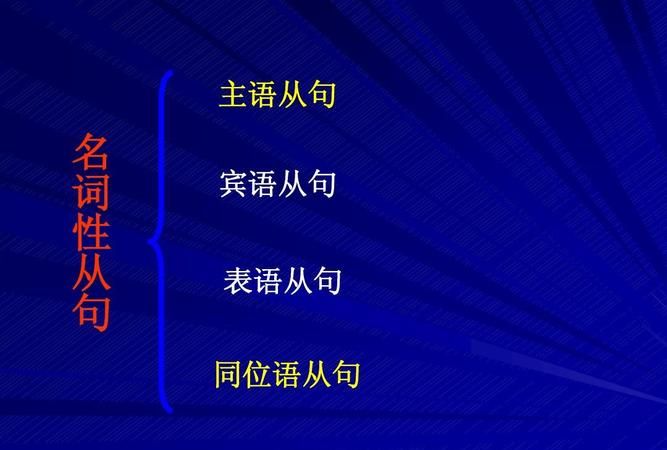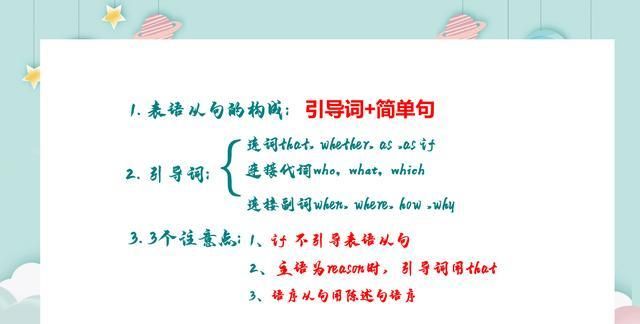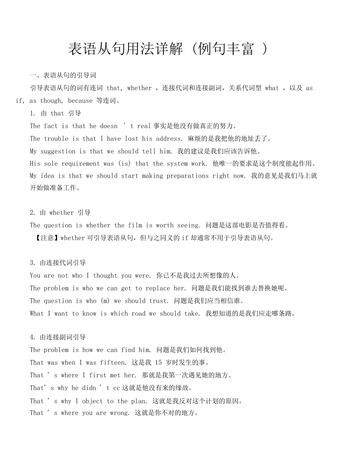本文目录
什么叫表语、表语从句、宾语从句和同位语从句 句子请归纳句型.
1.表语(一般是形容词,名词,跟在系动词(be)后面)
He is tall.(tall---表语)
It is water.(water)
2.表语从句(is + that/what/how/when/where 从句)当表语用的句子
The problem is (how/when to get there)
3.宾语从句( do + that/how)充当宾语的句子
I know (that she likes you)
4.同位语从句 (当同位语用的句子)
Tom ,(who is the monitor),is very rude.

什么是表语从句
共同点:都是名词性从句
不同点:在句子中充当的成分不一样
主语+连系动词+句子作表语(表语从句)
跟在动词后面的从句就是宾语从句
同位语从句的作用相当于一个名词,与它前面的名词是同位关系 用来解释说明名词的内容
主语从句通常放在主语动词之前或者由形式主语it代替。

英语八大从句类型与用法总结图
从句,即从属子句,是复句中具有分属地位的分句,它是一种绝大部分语言都有的语法结构。在现代汉语的语法中,“从句”不作为专业术语被使用。在现代英语的语法中,从句指复合句中不能独立成句,但具有主语部分和谓语部分,由that、who、whom、when、why、where、how、whether、which等引导词(Connective)引导的非主句部分。
从句用法总结
1.主语从句
1)主语从句可直接位于主语的位置,如果从句较长,谓语又较短,可用it作形式主语,而将从句放在句末。常见的句型有:
*It is a fact\a pity\a question\good news that...
*It seems\appears\happened\has turned out that...
*It is clear\important\likely\possible that...
*It is said\reported\estimated\has been proved that...
It is said that comic books create a connection between people of the same generation.
It seems that the performance is very useful.
2)what引导的主语从句表示“...的东西时”,一般不用it作形式主语。
What we lack is experience.
3)what,who,when,why,whether等词含有各自的疑问意义,但它们引导的主语从句,都用陈述语序。
How the plan is to be carried out should be discussed again.
I did know why I felt like crying.
2.宾语从句
1)宾语从句可位于及物动词、介词和某些形容词后。连词that常可省略。介词后一般接疑问词引导的宾语从句。in that(因为),except that(除了),but that(只是)已构成固定搭配,其他介词后一般不接that引导的宾语从句。
*I promised that I would change the situation.
*All this is different from what American young people would say about friendship.
*He is certain that watching so much television is not good for children.
*This article is well-written except that it is a bit too long.
2)宾语从句后如有宾补,要用形式宾语it来代替,而把宾语从句移至宾补之后。
He has made it clear that he would not change his mind.
3)在think,believe,suppose,expect等动词后的宾语从句中,如果谓语是否定的,一般将否定词移至主句谓语上,宾语从句则变成肯定形式。
He didn't think that the money was well spent.
3.表语从句
表语从句出现在结构为“主语+系动词+表语从句”的句子中。表语从句除可用that,what,when,why,whether,how等引导外,还可由because,as if(though)等引导。that常可省略。如主句主语为reason,只能用that引导表语从句,不可用because.
Perhaps the most important thing to remember is that there is no one common type of life in America.
The reason why so many people died there is that there were not enough food supplies.
It looks as if successful international cultural communication will make the world smaller.
4.同位语从句
同位语从句用于对前面出现的名词作进一步说明,一般用连词that引导,由于先行名词的意义不同,也可用whether,who,when,where,what,why,how等引导。常见的先行名词有fact,idea,belief,news,hope,conclusion,evidence,suggestion,order,problem,report,decision.有时由于谓语较短,将同位语从句位于谓语之后。
She finally made the decision that she would join the fashion show.
I had no idea how many books I could borrow at a time.
The news came that their team had won the championship.
5.定语从句
定语从句所修饰的先行词可以是名词或代词,也可以是一个句子。定语从句通常位于先行词之后,由关系代词或关系副词引导。
*限制性定语从句
限制性定语从句修饰先行词,对先行词起修饰作用,紧接先行词之后,无逗号,若省去,原句意思不完整。引导定语从句的关系代词有who,whom,whose,which,that等。who,whom,whose用于指人,whose有时也可指物,相当于of which;which用于指物;that既可指人也可指物,但只用于限制性定语从句中。关系代词除了引导定语从句,替代先行词外,还在从句中担任主语、宾语、定语等。
The computers and cables which make up the Internet are owned by people and organizations.
Those who live alone or who are sick may have trouble in getting close to other people.
The girl whose parents died in an accident is living with her grandmother.
1)当先行词是all,anything,everything,something,nothing等不定代词或先行词前有first,last,any,few,much,some,no,only以及形容词最高级修饰时,只能用关系代词that引导从句。
That is all that I've heard from him.
He's the first person that I'm going to interview this afternoon.
2)关系代词的省略
在从句中作宾语的关系代词常可省略。关系代词紧跟介词,作介词宾语时不可用that,只可用which或whom引导从句,并且不可省略,但当介词位于宾语从句句末时,作为介词宾语的关系代词仍可用that,也可省略。
This is one of those things with which we have to put up.
This is one of those things (which\that) we have to put up with.
3)引导定语从句的关系副词有when,where,why等。关系副词在从句中作状语,意义上相当于一个“介词+which”的结构。
Even in comic books where(=in which) there are no words,the stories are fully expressed through the drawings.
No one knows the reason why(=for which) he was so angry that day.
5.定语从句
*非限制性定语从句
非限制性定语从句既可修饰先行词,也可修饰整个主句,起补充说明作用,与主句之间有逗号隔开,若省去,原句意思不受影响。不可用that引导非限制性定语从句。关系词不可省略。
Every object has a gravitational pull,which is rather like magnetism.
*“介词+which\whom\whose”引导的定语从句
“介词+which\whom\whose”可引导限制性定语从句,也可引导非限制性定语从句,该结构中介词的选择取决于从句谓语动词的固定搭配,或先行词的习惯搭配。
This is the computer on which he spent all his savings
It is written by a person with whom we are all familiar.
*as引导的定语从句
as引导的定语从句主要用于“such...as”及“the same...as”的结构中,代替先行词是人或物的名词。as引导非限制性定语从句时,代替整个主句,从句可位于主句之前、之后或中间。
These are not such problems as can be easily solved.(as代替先行词problems)
As is mentioned above,no single company or group can control what happens on the Internet.(as代替主语)
英语八类状语从句的用法归纳
一、概说
状语从句即指在主从复合句用作状语的从句。按照其意义,状语从句可分为时间状语从句、地点状语从句、原因状语从句、目的状语从句、结果状语从句、条件状语从句、让步状语从句等。状语从句是高中英语学习中的一个语法重点,也是历年高考重点考查的内容之一。学习状语从句主要应注意引导状语从句的从属连词的用法与区别,以及从属连词在一定的语言环境中的意义与用法。
二、时间状语从句
1.引导时间状语从句的从属连词很多,常见的有before,after,when,while,as,since,till,until,assoonas等。
2.表示“当…时候”的while,when,as的用法区别是:while从句中的谓语动词必须是延续性动词;表示带有规律性的“每当”或当主、从句谓语动词的动作发生有先后时,只能用when;当表示“一边…一边…”或“随着”时,只能用as。另外,用于此义的as所引导的时间状语从句谓语只能是动作动词,不能是状态动词。如下面一道高考题的答案是B而不能是A:
“I’mgoingtothepostoffice.”“_____you’rethere,canyougetmesomestamps?”
A.As B.While C.Because D.If
3.until在肯定句中通常只连用延续性动词,表示相应动作结束的时间;在否定句中通常连用非延续性动词,表示相应动作开始的时间,意为“直到…才”。如:
Hewaiteduntilshewasabouttoleave.他等着一直到她准备离开。
Ididnotbegintoworktillhehadgone.他走了后我才开始工作。
4.表示“一…就”除用assoonas外,还可用theminute,thesecond,theinstant,immediately,directly,instantly,nosooner…than,hardly…when等。如:
Icameimmediatelyyoucalled.你一来电话我就来了。
Hardlyhadshearrivedwhenitbegantosnow.她刚到就下起雪来了。
ThemomentIhavefinishedI'llgiveyouacall.我一干完就给你打电话。
5.everytime,eachtime,(the)nexttime,(the)lasttime,bythetime,thefirsttime,anytime等以time结尾的词语也可用作连词,引导时间状语从句。如:
Nexttimeyoucomein,pleaseclosethedoor.下次你进来,请关门。
Hedidn’ttellmeanythingthelasttimeIsawhim.上次我见到他时他什么也没告诉我。
BythetimeIgothome,shehadalreadygonetobed.我到家时她已睡觉了。
三、条件状语从句
1.引导条件状语从句的从属连词主要有if,unless,as[so]longas等。如:
Don’tcomeunlessItelephone.除非我打电话,否则你别来。
Ifyouwatchcarefullyyouwillseehowtodoit.如果你仔细瞧你会看出该怎样做。
Aslongasyoudoyourbest,we’llbehappy.只要你尽力,我们就满意了。
2.incase也可引导条件状语从句,其意为“如果”、“万一”。如:
IncaseIforget,pleaseremindmeaboutit.如果我忘了,请提醒我。
四、让步状语从句
1.引导让步状语从句的从属连词主要有although,though,however(=nomatterhow),evenif(即使),whether…or(不论…还是)等连词。如:
Thespeechisgood,thoughitcouldbebetter.这次演讲不错,虽然还可以再好一点。
Hewentouteventhoughitwasraining.尽管下雨,他还是出去了。
2.as也可引导让步状语从句,但要将名词、形容词或副词等提到as前,若提前的是单数可数名词,要省略a/an。如:
Teacherasheis,hecan’tknoweverything.虽然是老师,他也不可能什么都懂。
3.连词while有时也可表示“尽管”、“虽然”,引导让步状语从句。如:
Whilewedon’tagreewecontinuetobefriends.尽管我们意见不同,我们还是朋友。
4.whatever,whoever,however,whenever,wherever等引导让步状语从句。如:
Don’tloseheartwhateveryoudo.不管你做什么,都不要灰心。
Whoeveryouare,youcan’tpassthisway.不管你是谁,你都不能从这里通过。
注:表示“虽然”的though,although不可与but连用,但可与yet,still连用。
五、原因状语从句
1.引导原因状语从句的从属连词主要有because,as,since,seeing(that),now(that)等:
Theycan’thavegoneoutbecausethelight’son.他们不可能出去了,因为灯还亮着。
Sinceyouaregoing,Iwillgo.既然你去,我也去。
Nowthatwearealone,wecanspeakfreely.现在我们单独在一起,可以随便谈了。
2.除以上提到的大家比较熟悉的引导原因状语从句的从属连词外,when有时也可引导原因状语从句,其意“既然”。如:
Ican’ttellyouwhenyouwon'tlisten.既然你不想听,我就不告诉你了。
3.有关原因状语从句还应注意以下几点:
(1)as与since,nowthat一样表示双方都知道的原因,通常位于主句前,且均不可用于强调结构被强调。
(2)当表示直接的因果关系,回答why时,或有only,just,all,partly,not,but等副词修饰时,或用在强调结构中都只能用because。
(3)for有时也可引出表示原因的分句,但它只能位于后面,对前一分句加以解释或推断。
(4)不要受汉语意思影响将表示“因为”的连词与表示“所以”的so连用。
六、地点状语从句
引导地点状语从句的从属连词主要有where(在…的地方),wherever(无论什么地方),everywhere(每个…地方),anywhere(任何…地方)。如:
I’mnotlivingwhereIwas.我不在原处住了。
Youcan’tcampwhere[wherever,anywhere]youlikethesedays.如今你可不能随便在哪儿宿营。
EverywhereIgo,Ifindthesamething.不管我走到哪里,我都发现同样情况。
2.有的同学认为地点状语从句在平时见得不多,误认为考试不会涉及,但恰恰相反,地点状语从句却是英语考试经常考查的一个知识点。请看以下考题:
(1)Whenyoureadthebook,you’dbettermakeamark_____youhaveanyquestions.
A.atwhich B.atwhere C.theplacewhere D.where
(2)Afterthewar,anewschoolbuildingwasputup_____therehadoncebeenatheatre.
A.that B.where C.which D.when
(3)Youshouldmakeitaruletoleavethings_____youcanfindthemagain.
A.when B.where C.then D.there
(4)Shefoundhercalculator______shelostit.
A.where B.when C.inwhich D.that
以上四题均选where,其意为“在…的地方”,用以引导地点状语从句。
七、目的状语从句
1.引导目的状语从句的从属连词主要有inorderthat,sothat,incase,forfear等。如:
IhiredaboatsothatIcouldgofishing.我租了一条船去钓鱼。
Takeyourcoatincaseitrains(shouldrain).带着雨衣以防下雨。
Hestudiedhardinorderthathecouldpasstheexam.他努力学习,是为了能通过考试。
2.引导目的状语从句的sothat有时可省so或that,即单独用so或that来引导目的状语从句。如:
Checkcarefully,soanymistakewillbecaught.仔细检查,以便任何错误都可检查出。
BringitcloserthatImightseeitbetter.拿近些,使我能看得清楚些。
八、结果状语从句
引导结果状语从句的从属连词主要有sothat,so…that,such…that等。如:
Hewassoangrythathecouldn'tspeak.他气得话都说不出来。
Heshutthewindowwithsuchforcethattheglassbroke.他关窗子用力很大,结果玻璃震破了。
注:so…that和such…that中的that有时(尤其在口语中)可省略。

表语从句虚拟语气的用法归纳
表语从句用法归纳:
1、表语从句概说
表语从句即在主从复合句中用作表语的从句。引导表语从句的词有连词that,whether,连接代词和连接副词以及as if,as though,because等连词。
(1)My idea is that we should do it at once。我的想法是我们应该马上做。
(2)The question is whether he is honest。问题是他是否诚实。
(3)The problem is how we can find him。问题是我们如何找到他。

(4)That was when I was fifteen这是。我15岁时发生的事。
(5)That's why I can't go with you。那就是我不能同你一起去的原因。
(6)It isn't as if you were going away for ever。又不是你离开不回来了。
(7)It is because I love you too much。那是因为我太爱你了。

2、两点重要说明:
(1) whether可引导表语从句,但与之同义的if却通常不用于引导表语从句;because可引导表语从句,但与之同义的since,as,for等也不用于引导表语从句。
(2) 引导表语从句的that通常不省略,但在口语或非正式文体中有时也可省略:The trouble is (that)he is ill。糟糕的是他病了。
顺便说一句,引导主语从句that通常也不能省略,但若句首使用了形式主语it,真正的的主语从句位于句末时,that有时也可省略。
以上就是关于表语从句归纳,表语从句用法归纳的全部内容,以及表语从句归纳 的相关内容,希望能够帮到您。

